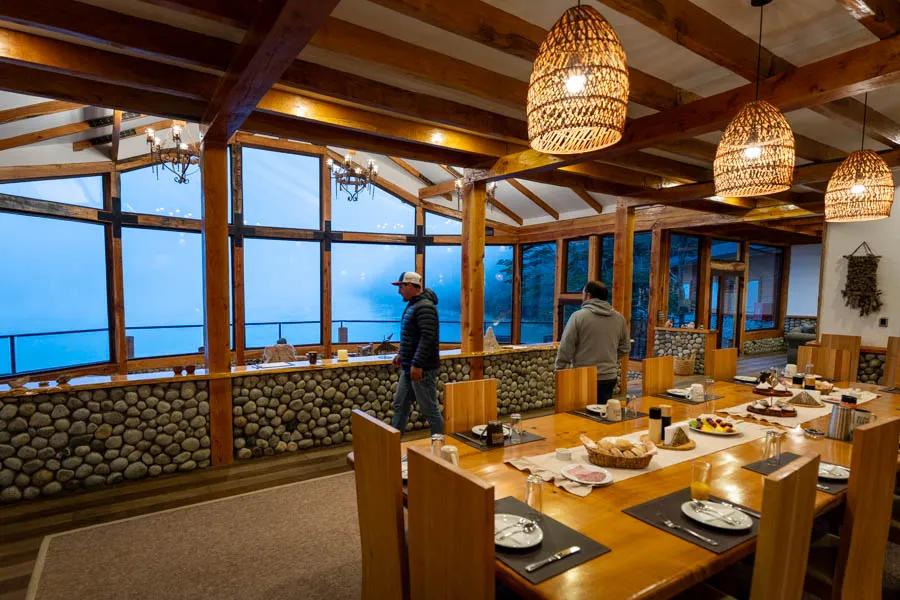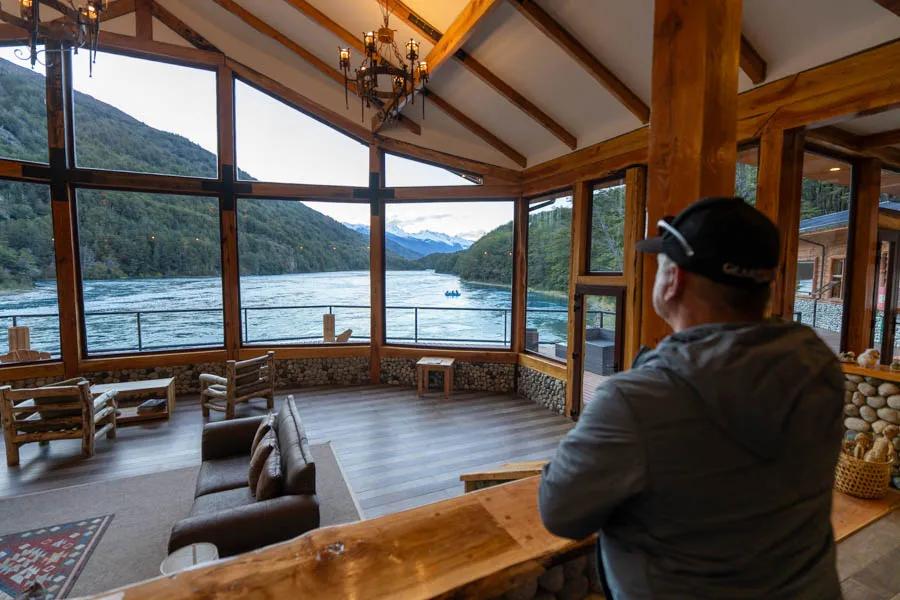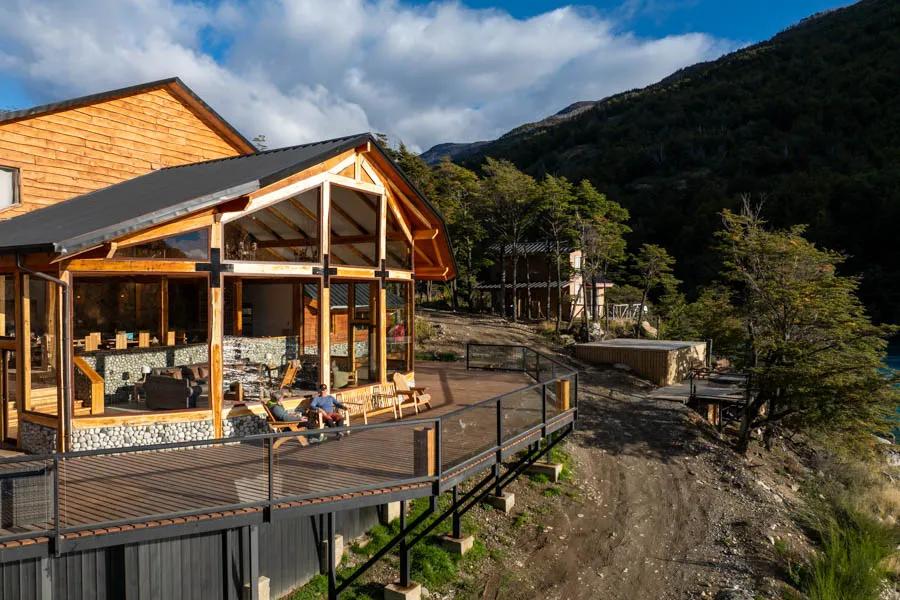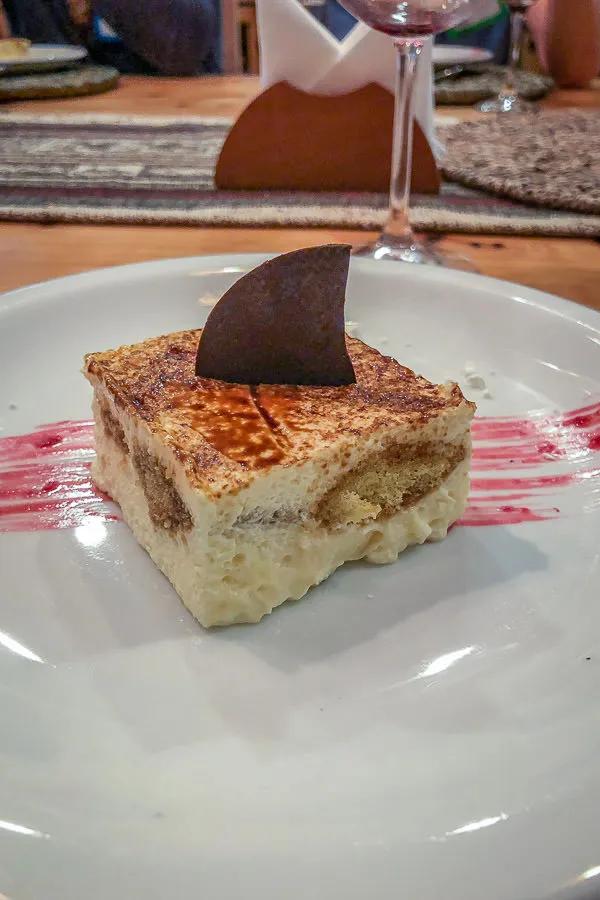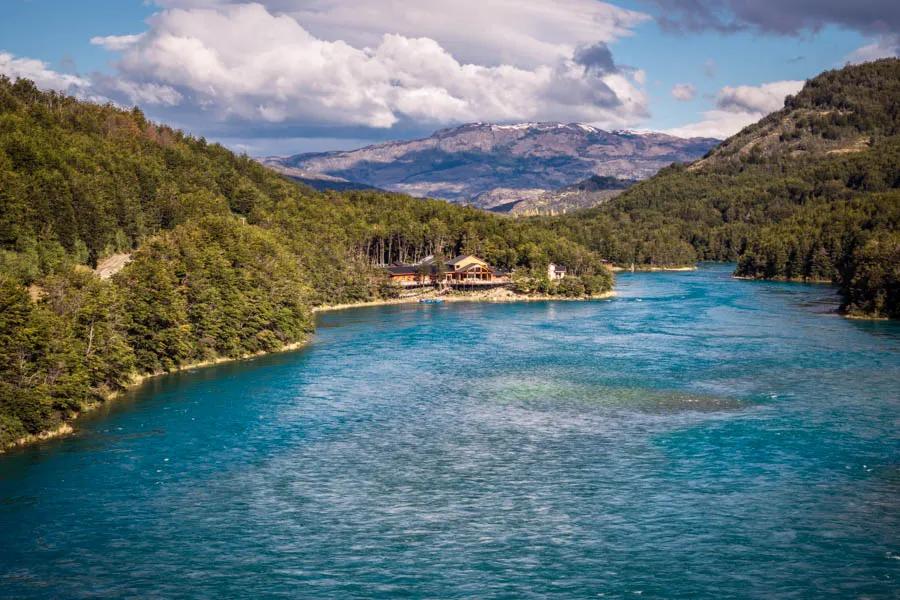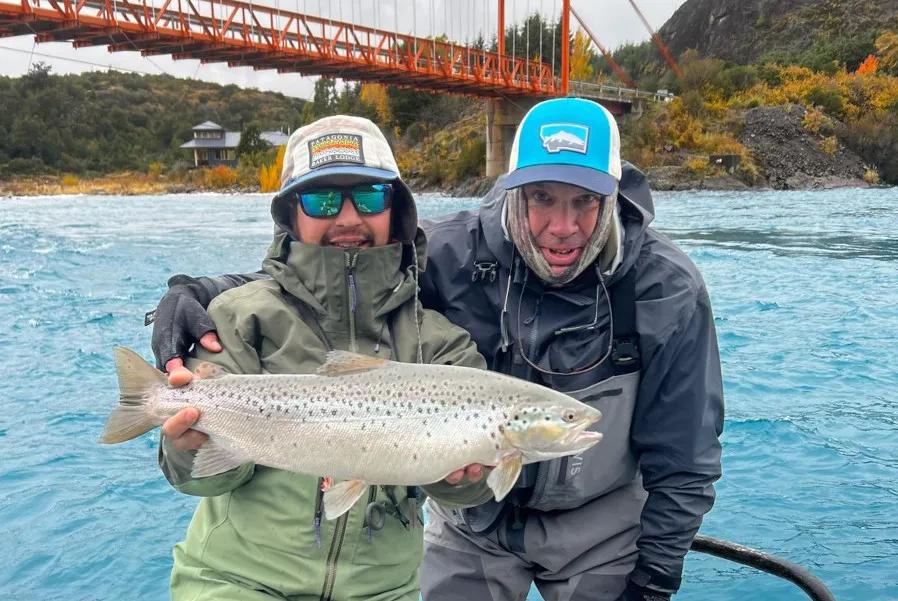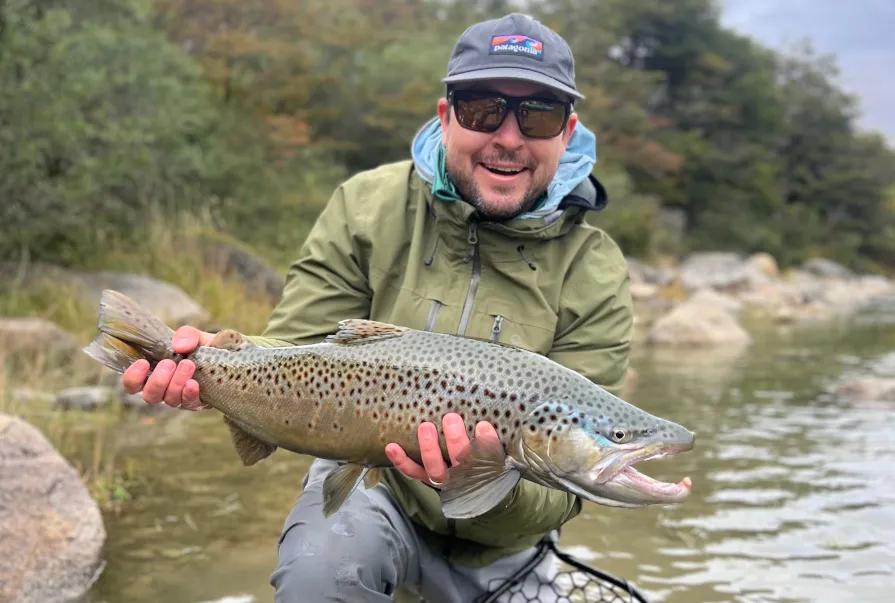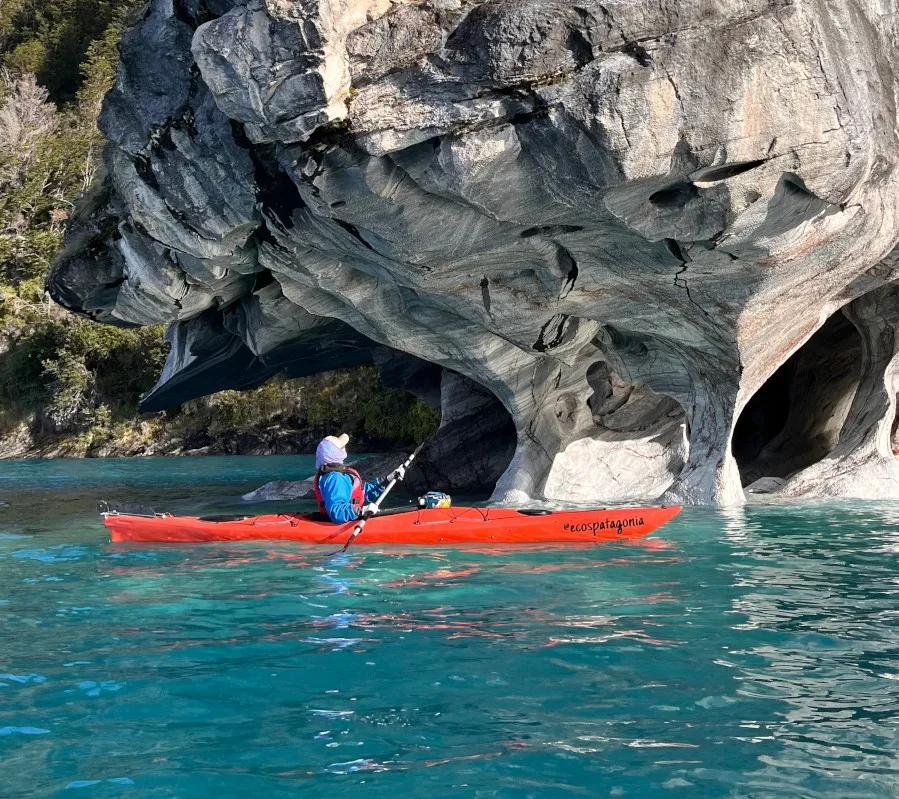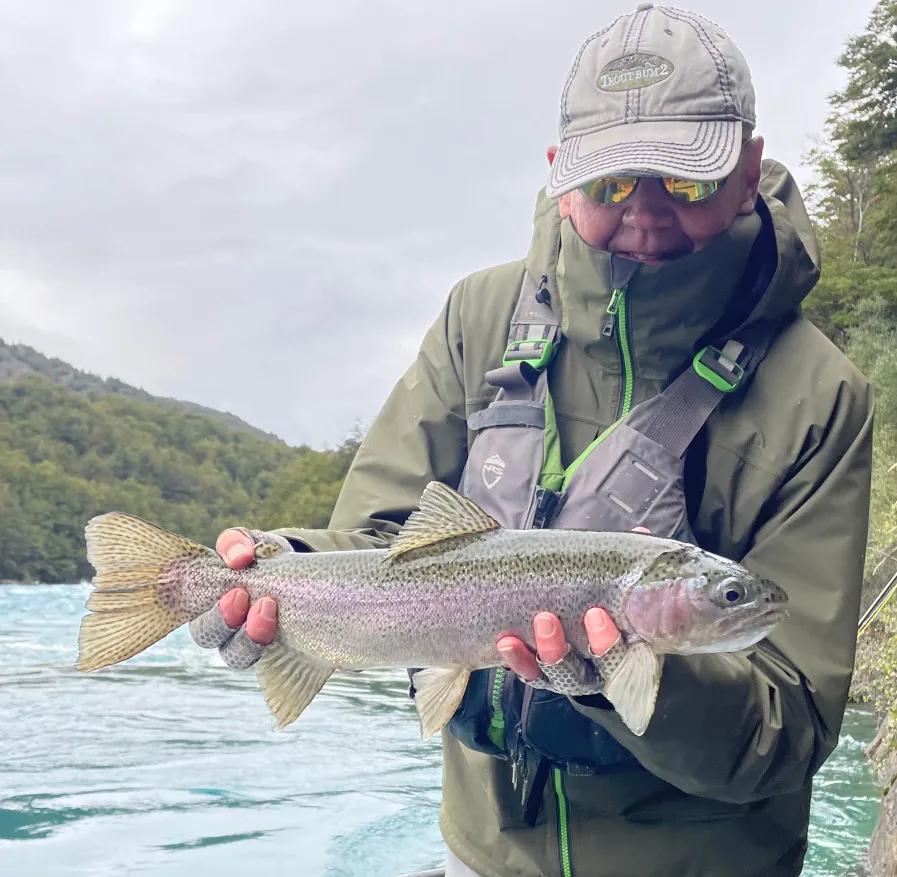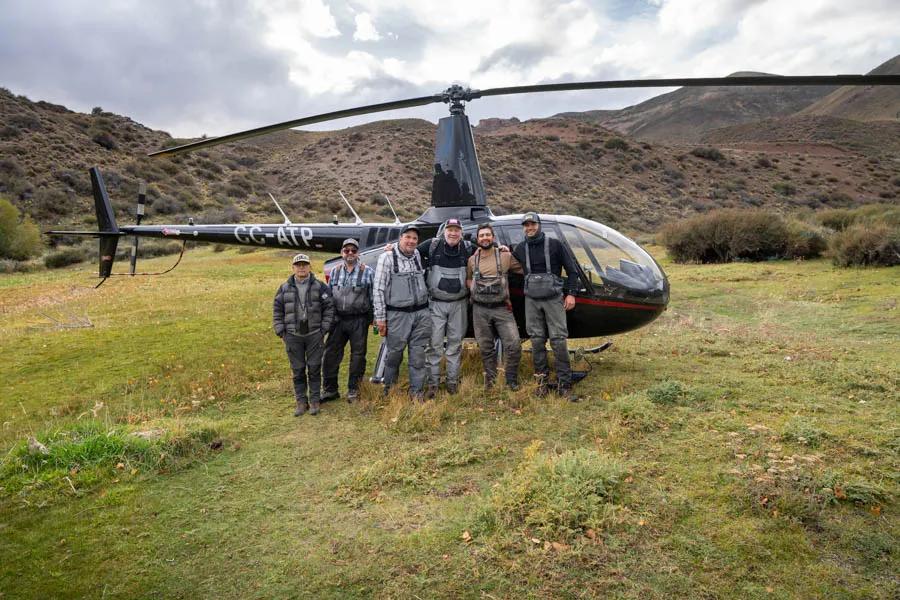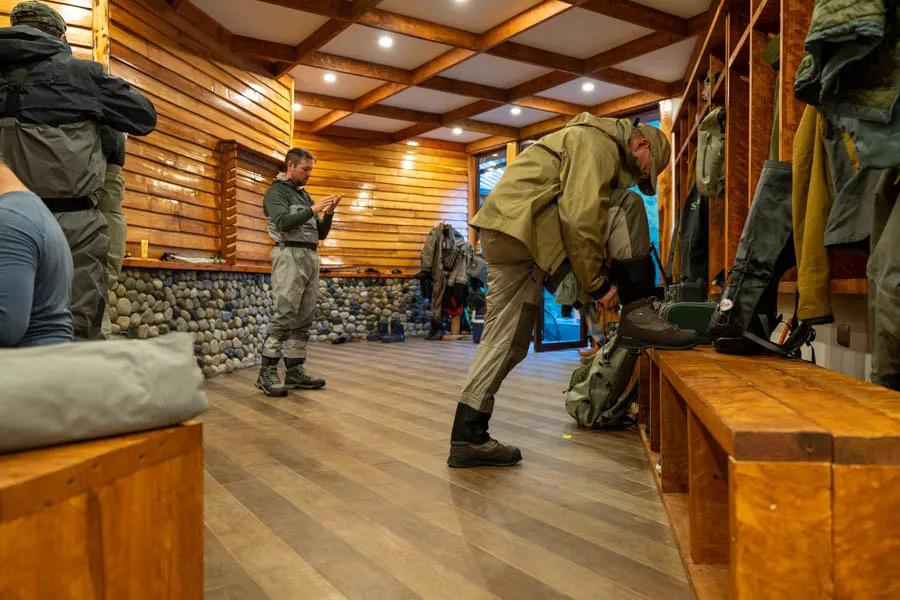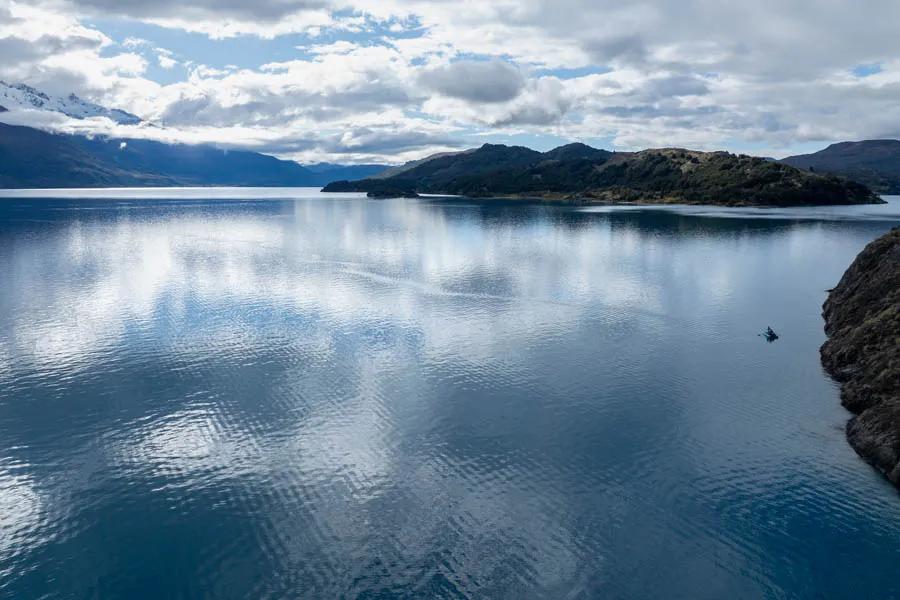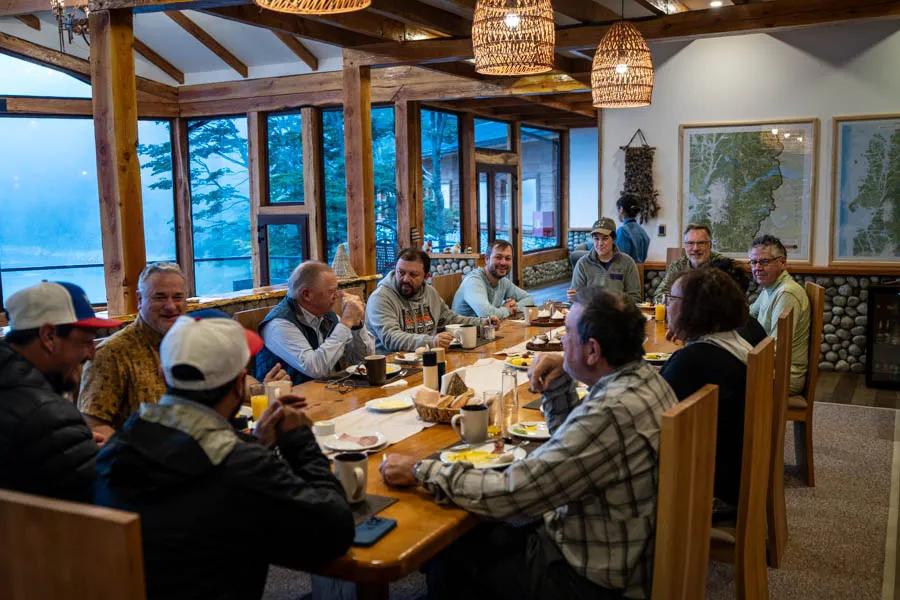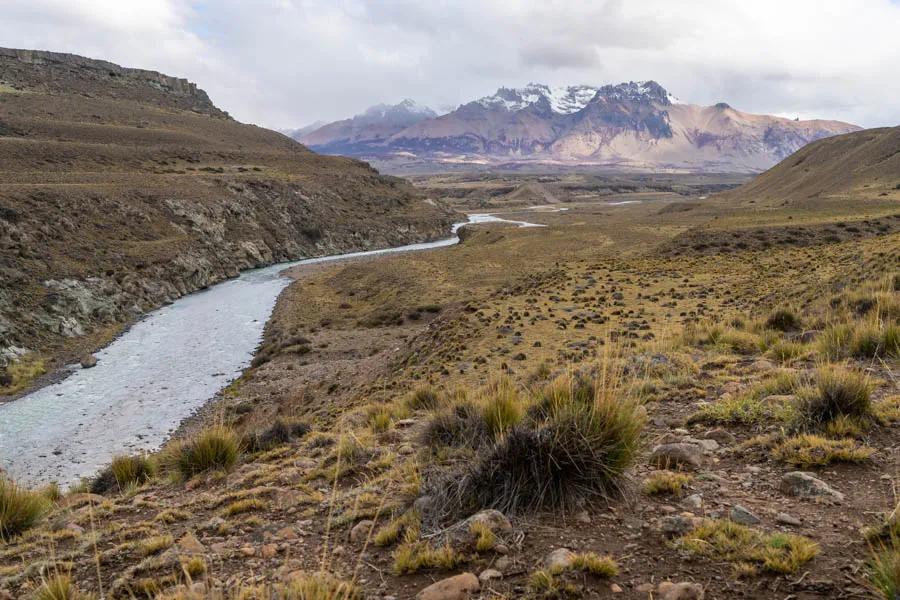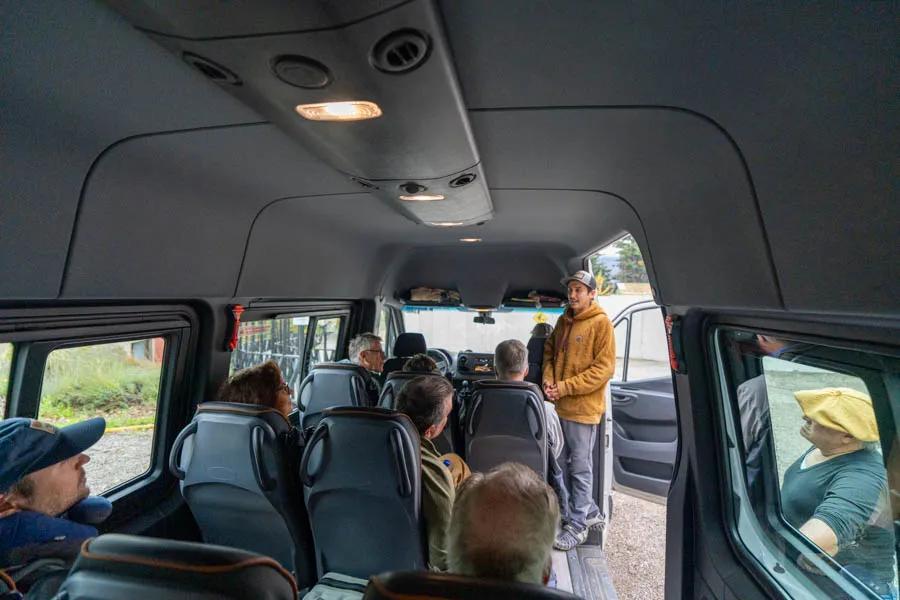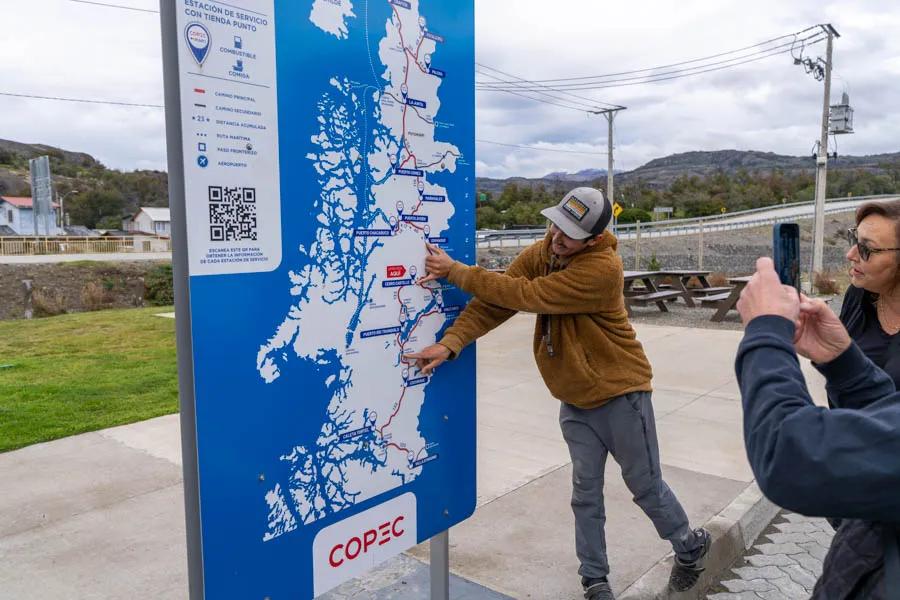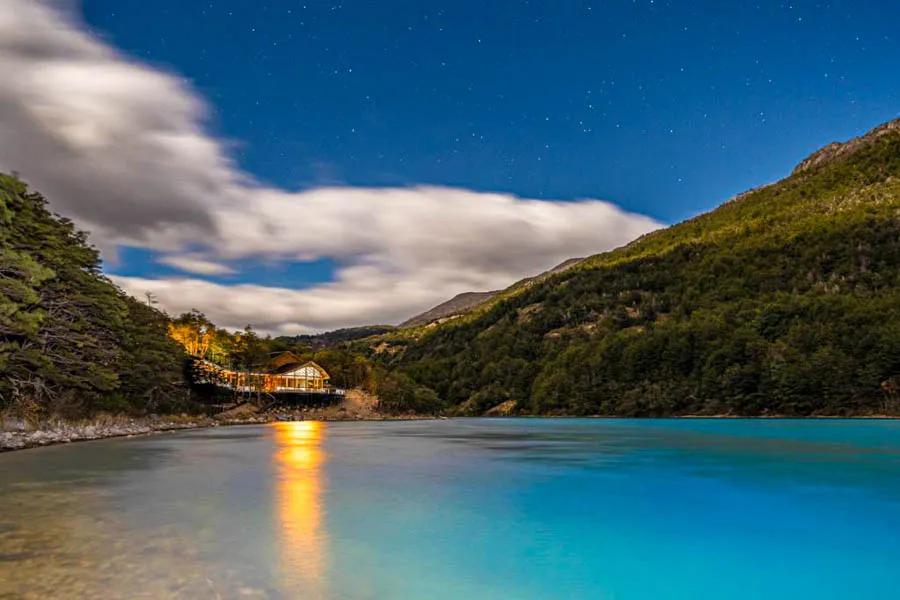
Patagonia’s Rio Baker is mesmerising. In a region filled with national parks, glaciers, and lakes as deep and cold as they have been for thousands of years, it takes a special river–and a special lodge–to stand out in this perpetually inspiring region of the Earth. If the abundance of large trout isn’t enough to draw you to this one-of-a-kind region, the fishing program and guides at Patagonia Baker Lodge are some of the best in all of Patagonia.
This is a remote and rugged landscape, accessible only by one gravel road–the Carretera Austral–and is home to some of the largest river-dwelling trout on the planet. But catching big trout requires a sense of adventure. A trip to Patagonia Baker Lodge is a commitment to long days on the water with passionate and excellent guides, and ending those days at one of the premiere destination fishing lodges in all of Patagonia.
I was fortunate to be the Montana Angler host with a group of anglers in late April. Our group consisted of several very experienced anglers and a few beginning and intermediate anglers. For some of us we’d been to Patagonia before, for others this was their first fly fishing trip in Chile or Argentina.
Travel to Patagonia Baker Lodge: National Parks, Glaciers, and Patagonia’s Largest Lake
I’ve been fly fishing for over 40 years now. To pillage a little bit from Ralph Waldo Emerson, fly fishing should be treated as a journey and not a destination. But as fly fishing trips go, a trip to Patagonia Baker Lodge is both the journey and the destination.
As remote as any fly fishing lodge in Chile, getting to Patagonia Baker Lodge requires traveling 5.5 hours from Coyhaique along the Carretera Austral or chartering a private helicopter. Both routes–land or air–take you through, or over, some of the most breathtaking and inspiring landscapes on Earth. I’ve spent several weeks fishing in Chilean and Argentine Patagonia and the ground transfer to Patagonia Baker Lodge was perhaps the most scenic half day of driving I’ve ever done. We even were able to see the drainage where Patagonia Baker Lodge's sister lodge, Magic Waters Lodge, is located.
Nearly every trip to Patagonia Baker Lodge requires an overnight stay in the small town of Coyhaique. Montana Angler arranged hotel rooms for our overnight layover that had easy access to Coyhaique’s cultural town center. You can read more at the bottom of this trip report about our layover in Coyhaique. The next morning we were met at the hotel by our driver, Orlando, and a very comfortable taxi van.
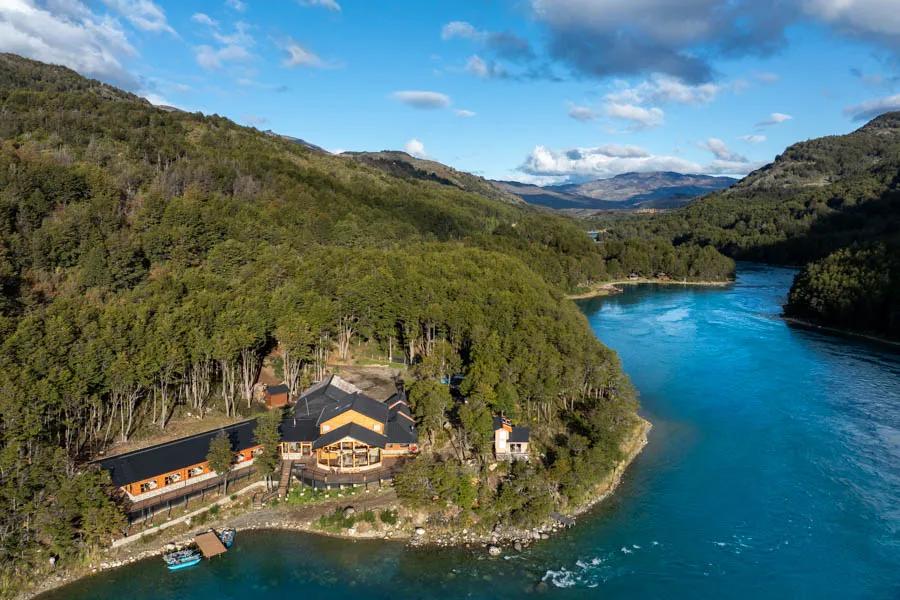
Our trip occurred in the heart of Autumn and the color blasts of changing leaves highlighted the hillsides and valley bottoms. In every direction snowcapped peaks climbed into the clouds as we traveled further south from Coyhaique, the route taking us through Cerro Castillos National Park, across and along the Ibanez, Norte, and Murta Rivers, and eventually to the shoreline of Lago General Carrera. Still in awe of the scenery, we now traveled the shoreline of the largest lake in Patagonia–Lago General Carrera.
After a stop in Puerto Tranquillo and a quick walk to skip some rocks on Lago General Carrera, we loaded back into the van for the second half. A little over two hours later we began to drop into the Rio Baker drainage. Our driver Orlando gave us affirmation of getting closer. However, the thick tree cover along the road made it impossible to see the massive Rio Baker in the distance. It wasn’t until we reached the small village of Puerto Betrand and made a hard southerly turn, did the Rio Baker come into view.
The turquoise, glacial-flour colored water contrasted brilliantly with the dark green forested hillsides. The chatter of our group fell silent upon first viewing–the color of the Rio Baker looks otherworldly. The quiet was quickly broken with exclamations of “gorgeous..beautiful...like nothing I have ever seen…” and someone finally said “and lots of trout!”
Leading up to this trip I’d heard stories of the large trout of the Rio Baker, watched movies of anglers casting flies along the cliffs of Lago Betrand, seen photos of selective trout sipping mayflies on the Cochrane, dreamed of the rugged wildness of the Jeinimeni, and visioned the trophy-sized fish that swim in the waters off General Carrera Point. Patagonia Baker Lodge is located to fish all of these waters as well as some other lesser known, but equally fishy, waters. I was finally there.
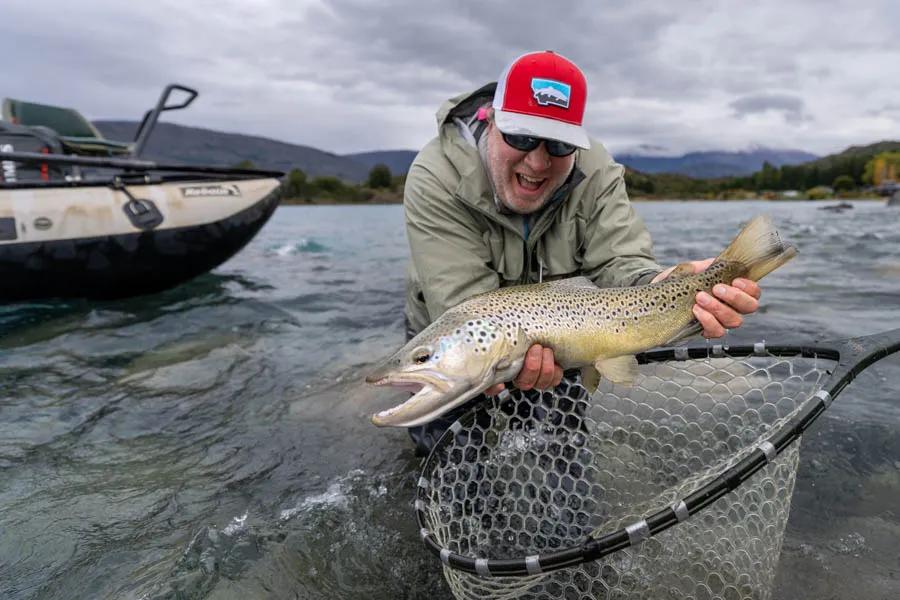
Patagonia Baker Lodge: Location is Everything
As if the fishing for large trout on the Rio Baker wasn’t reason enough to build this world-class fishing lodge, the owners, Eduardo and Consuelo Barrueto, were inspired by their very successful Magic Waters Lodge. They used the successful lodge layout and fishing program to create another home run in this remote area. In fact, in our group we had a couple anglers doing a two-week combo trip to both Patagonia Baker Lodge and Magic Waters Lodge.
The lodge is perched on a high bank on the Rio Baker. Each lodge room has a large picture window looking out to the river. There is a dock and boat ramp at the lodge. The dining room, living room, and fireplace gathering area all have massive windows as well. Spanning the entire reach of the lodge rooms and common areas is a large deck. The beauty of the Rio Baker along with its melodic rush of currents and the jagged peaks and hanging glaciers of San Rafael National Park are the backdrop for nearly every moment at the lodge. We were fishing at a similar time as our 2024 Hosted Trip.
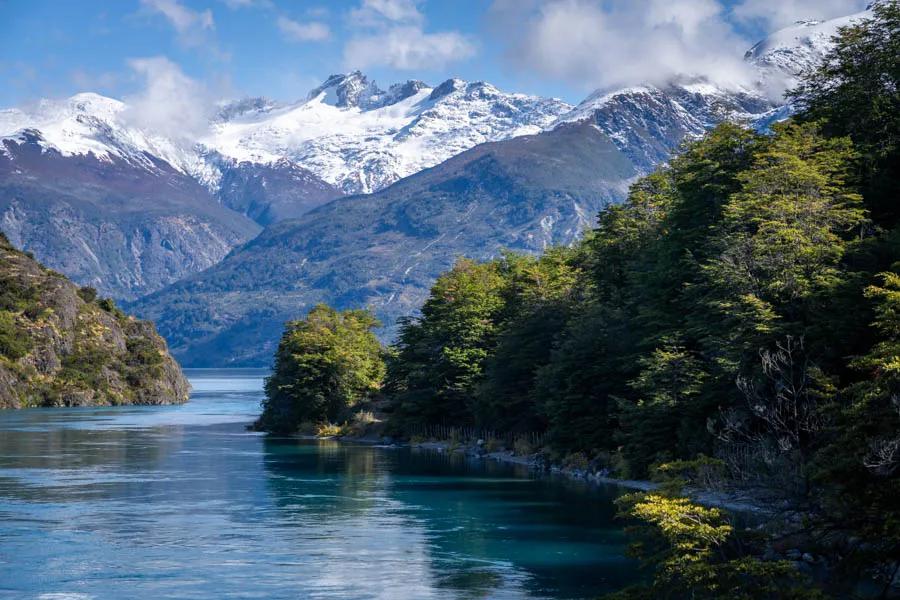
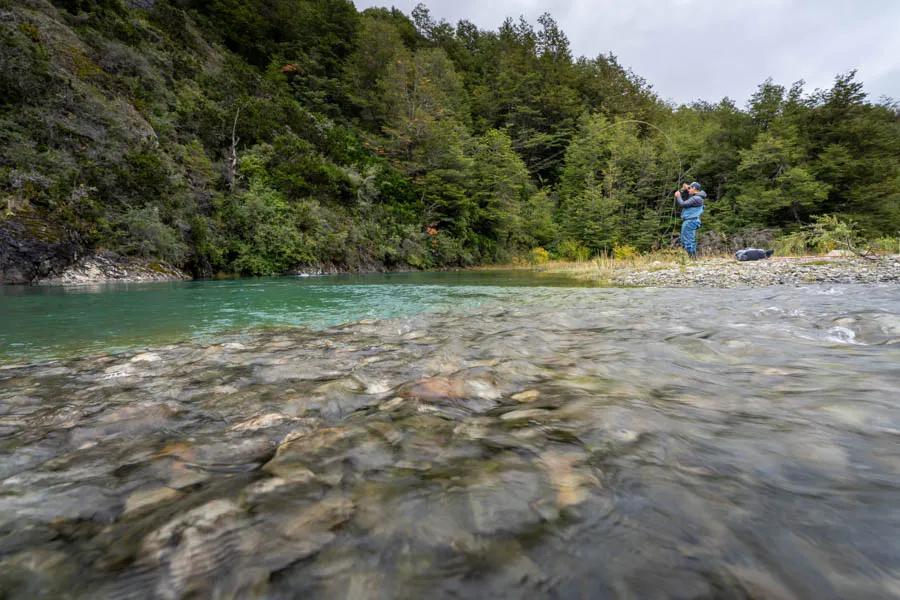
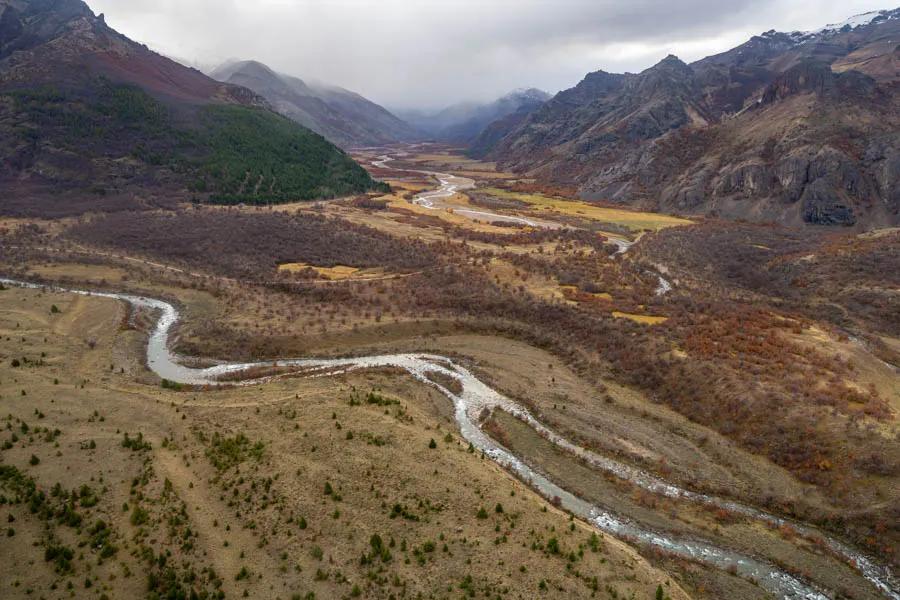
Upon our arrival we were welcomed with empanadas and our choice of cocktails. We settled into our rooms, enjoyed food, drink, and cigars on the deck while the currents of the turquoise waters of the Rio Baker flowed past. The head guide for the week, Marcelo, introduced himself and we all began organizing our gear for our first day of fishing.
We began to ready our fly lines and reels–we all had a variety of sinking, sink-tip, and floating lines. Rods were mostly six and seven weights and flies ranged from large articulated streamers to beadhead nymphs to large dry flies. With the abundance of fly fishing gear and anticipation for exploring new waters high, the lodge was filled with laughter and good vibes–our group was really coming together. The flowing drinks and appetizers also helped. Dinner was a fabulous mixed grill of filet mignon and pork tenderloin paired with Chilean wines. After a delectable desert most of us retired to rest up for our first day but a few others enjoyed the fireplace while learning more about hometowns, families, places fished, and other expectations for the week.
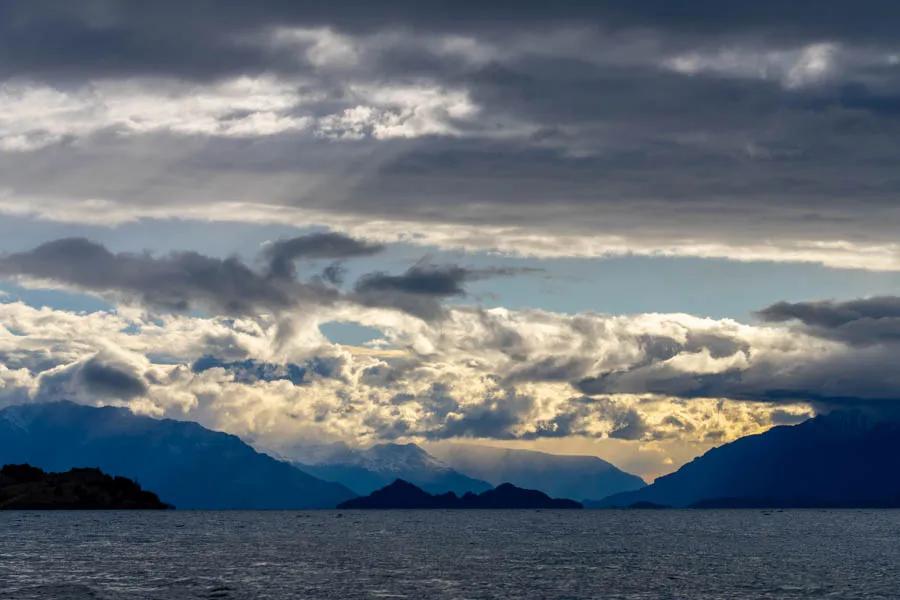
Day One: Lago Betrand and General Carrera Point
Because our week at Patagonia Baker Lodge was in the heart of the southern hemisphere’s Autumn season, mornings started later than most anglers may be accustomed to. On the first day everyone was up and at ‘em early. By the second and third days the later start was welcomed by all. Breakfasts of eggs to order and meats were available along with traditional Chilean breakfast offerings of fresh baked breads and slices of ham and cheese. Each morning we dined as the sun rose over the mountains and gradually lit up the waters of the Rio Baker.
On the first day I headed to General Carrea Point, referred to as Pasa Re La by the guides. Armed with a full sinking line on a seven weight and a sink-tip on a fast action six weight, I met Luciano and we loaded into his clean and comfortable Toyota 4Runner. After a short drive we launched the boat and began motoring out to our first fishing spot. Pasa Re La is where Lago General Carrera transitions through a narrow point and becomes Lago Betrand. At this “pass,” large brown trout are known to congregate.
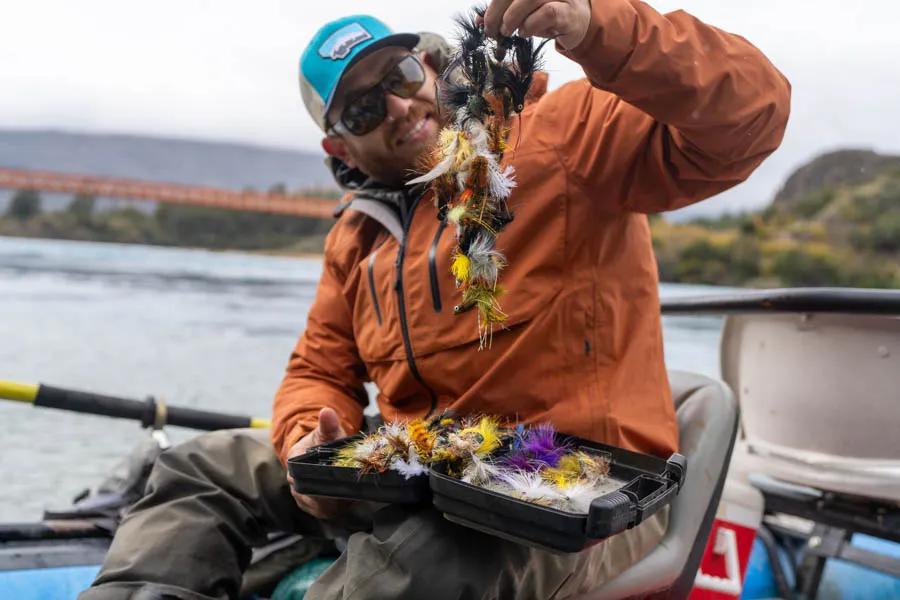
But it is also known to be quite windy. And, having been working with guides on trout rivers for decades, I could tell from Luciano’s reaction when we stepped out of the car that the wind today was not going to be our friend. We fished the pass and the main channel and had a few strikes, but I wasn’t able to get it done fast enough. We then left the pass area and drifted along many of the high cliff walls along the shore of Lago Betrand. We fished large articulated streamers on a sink-tip line. We moved several fish but it wasn’t until Luciano rowed me to where a small stream was surging due to recent hard rains and my first cast into the mixing waters was rewarded with a nice rainbow. Ice broken. Fish landed. We headed back to the pass in hopes of hooking into a big brown trout.
Luciano did an excellent job piloting and rowing the boat in the wind and I did a fine job of casting, but a large brown trout on day one was not in the cards. Because it was unusually windy and because I can row, Luciano and I traded off rowing so he could fish some and also get a break from the wind. We traded off rowing and fishing until Luciano said it was time to head back to the lodge. Once at the lodge the staff took my cocktail order and provided some appetizers–a great way to finish the first day.
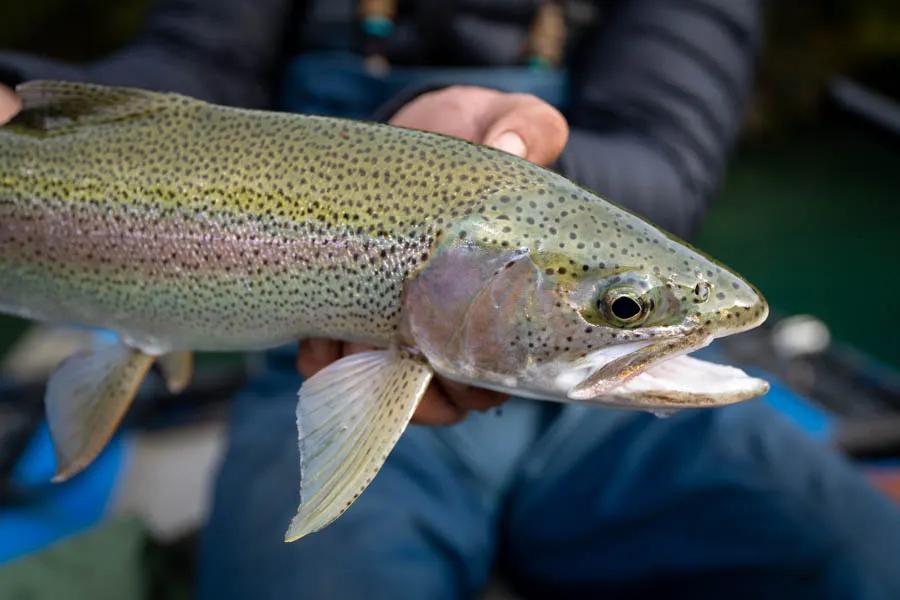
Day Two: Rio Baker Float Fishing
Day two broke with a little more sunshine than day one but the forecast for light showers in the morning meant breakfast could remain relaxed and unhurried. At breakfast I learned I was fishing the Rio Baker with the head guide, Marcelo. While I enjoyed my coffee on the deck and another sweet roll, Marcelo readied the cataraft for the day.
The Rio Baker begins as the outlet of Lago Betrand. The river cuts through a narrow canyon filled with whitewater and in less than eight miles tumbles down the largest waterfall in all of Patagonia. These eight miles of river are home to perhaps the planet’s highest concentration of easily accessible trophy-sized brown trout.
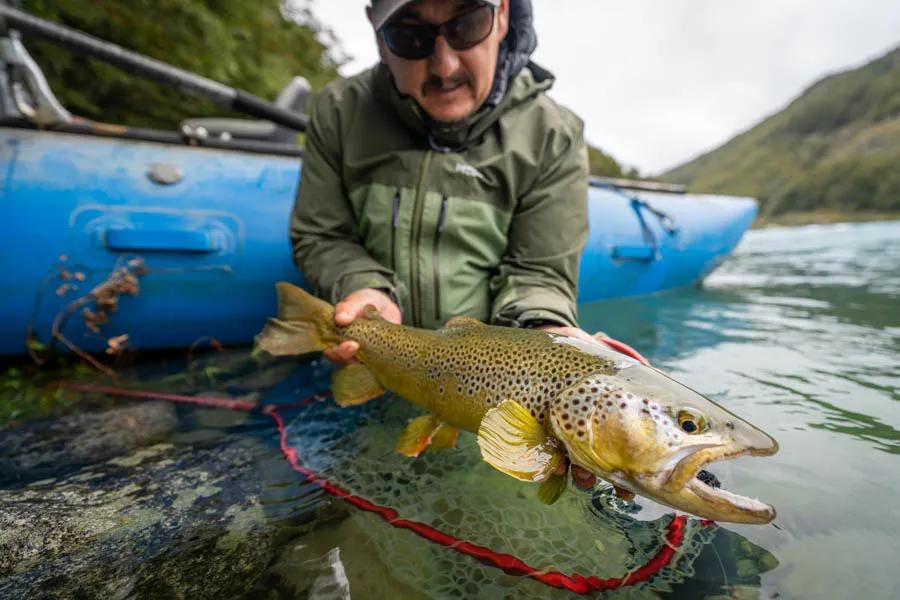
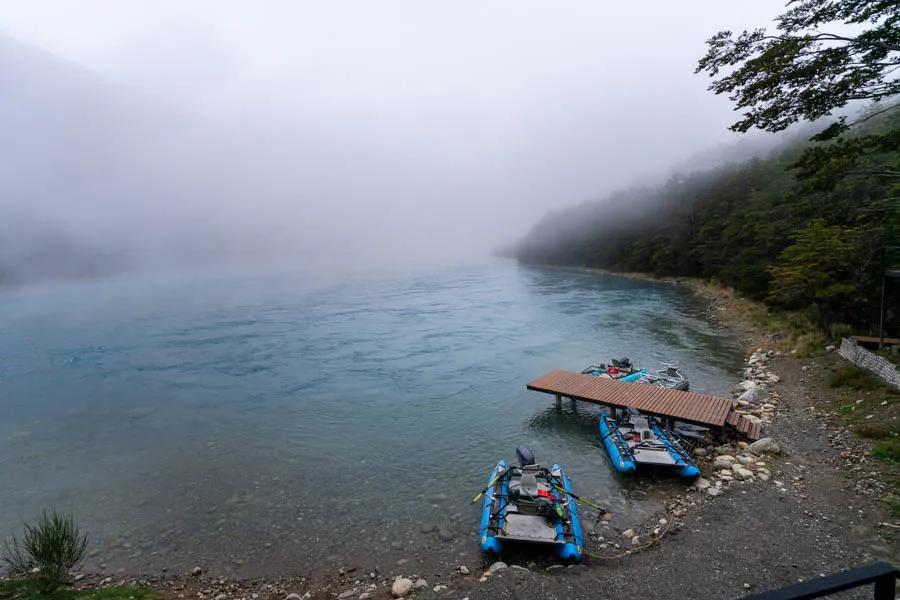
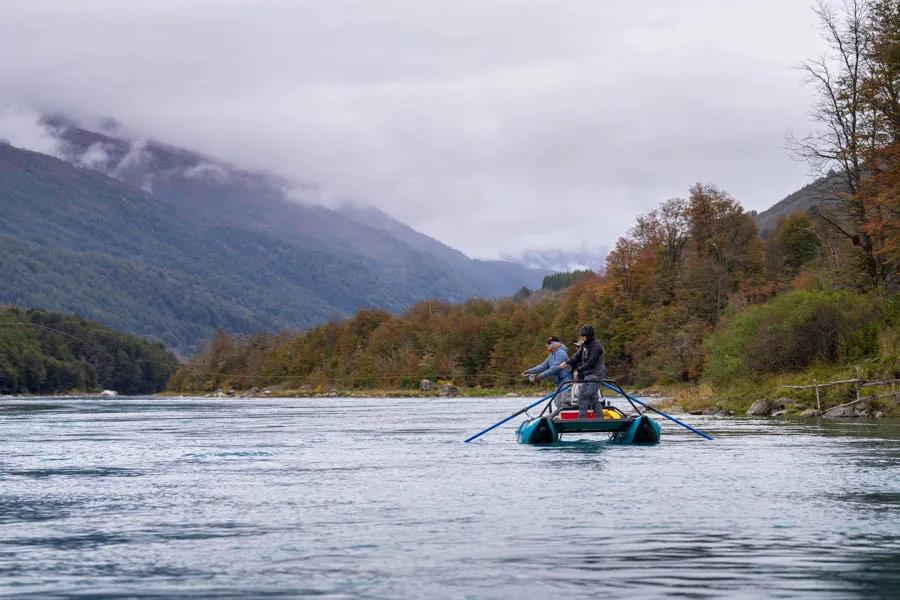
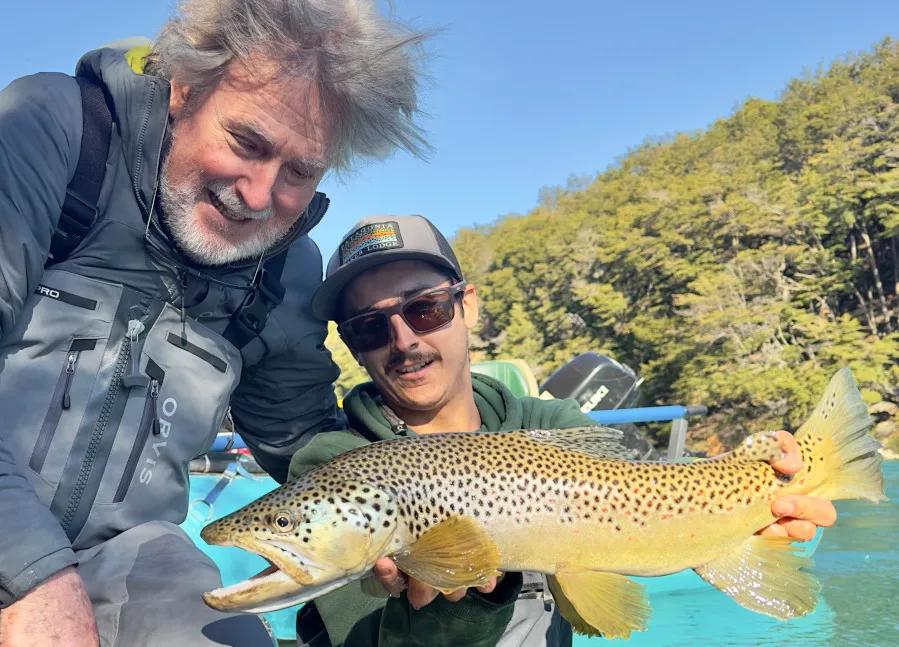
We made the two minute run in the cataraft up the river to begin fishing. I had my first strike so close to the lodge that through the picture window of my room, I could see I forgot to make my bed. We floated a few hundred yards downstream from the lodge and then motored back up–there was a side channel that I had asked Marcelo about and he was ready to explore it.
We parked at the lower end of the side channel and proceeded to stalk a few rising rainbows, catching them all on either a single Parachute Adams or smaller Purple Haze. All of this while still in eyesight of the lodge. The Rio Baker was legit!
With some nice fish to hand, it was time to hunt for big browns. Marcelo and I traded off rowing for the remainder of the day. We moved several decent sized brown trout on a large black Sculpzilla. Marcelo eventually sealed the deal on a nice 21+ inch brown shortly before lunch. We continued to float and fish the rest of the day and met up with my friends John and Rodney for lunch. Along with their guide, Augustin, John and Rodney were all smiles at lunch as they’d enjoyed a classic day on the Rio Baker–loads of good sized rainbows plucked from the many eddy lines and current seams and a few exciting takes from large brown trout. We also shared the Rio Baker that day with fellow trip guests Bill and Judy who also enjoyed a variety of action on dries, nymphs, and streamers.
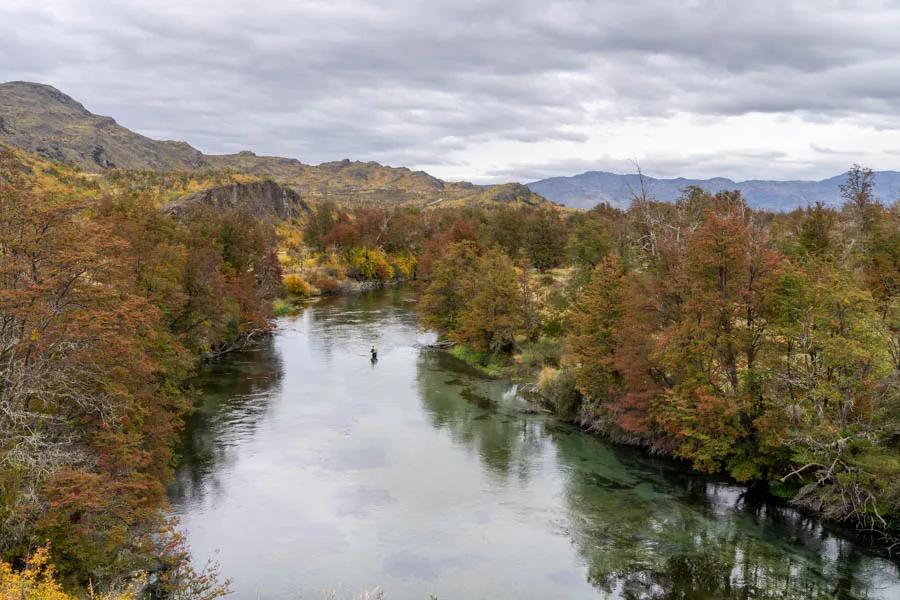
Day Three: Exploring the Cochrane and More Big Brown Trout
After two days of mostly fishing from a boat, it was time to walk and wade fish. We enjoyed breakfast as a spectacular sunrise broke through the clouds and shortly a bluebird, crisp Autumn sky was upon us. We received our pairings and our fishing location–I was off to fish the Cochrane River with Nico. Nico was born and raised within five miles of Patagonia Baker Lodge. Nico was enthusiastic about heading to the Cochrane despite its reputation preceding itself as a challenging fishery.
The plan for the day was to fish the Cochrane in the morning and then meet up with Eduardo, the owner of Patagonia Baker Lodge and Magic Waters Lodge, and try for a 30-incher at the Pasa Re La.
The Cochrane River flows out of Cochrane Lake and through the town of Cochrane. Unlike many of the other rivers in the area that are fed by lakes that have a substantial amount of glaciers that flow into them, the Cochrane River flows clear and cold year-round. This consistency creates a river resembling the famous spring creeks of the western United States or Pennsylvania. The trout in the Cochrane grow to be large, yet cunning and hard to come by.
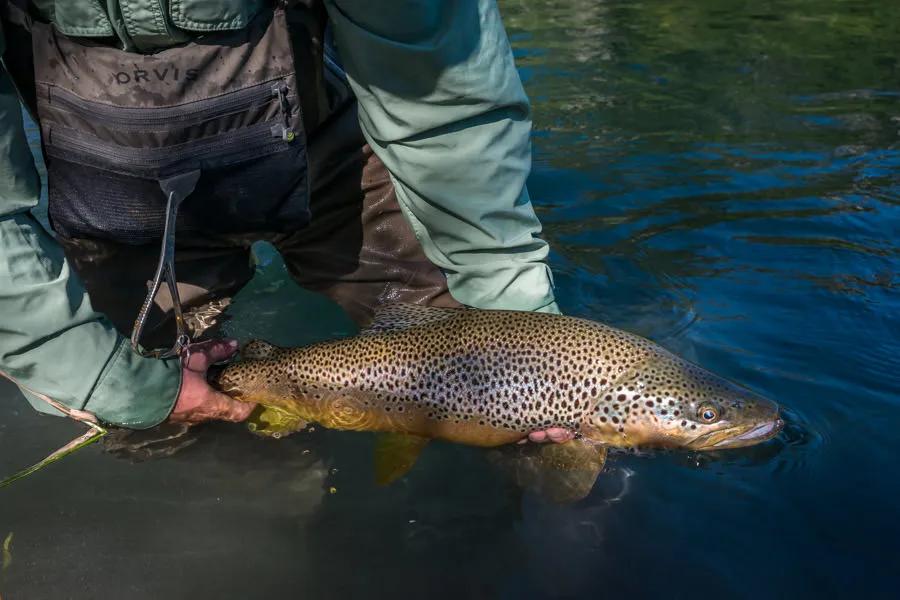
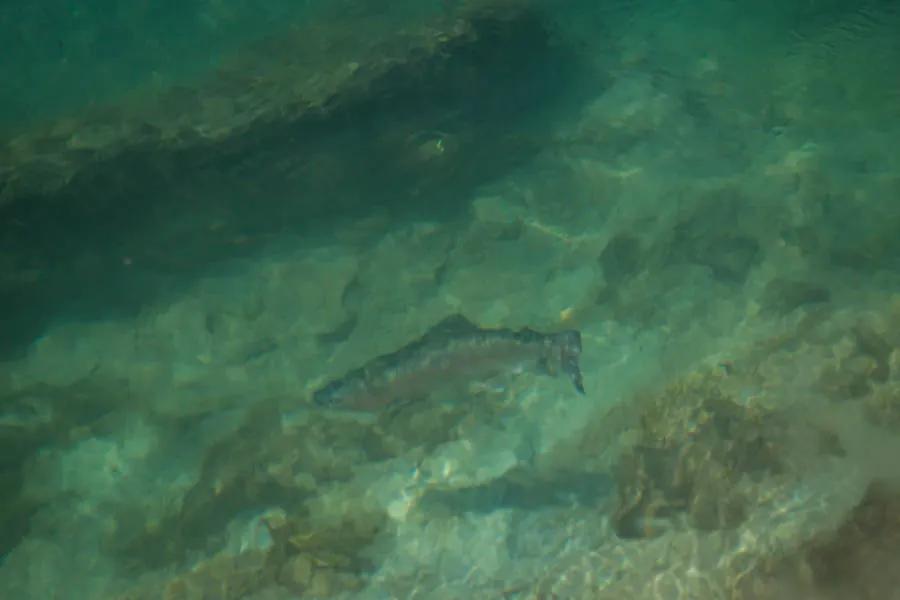
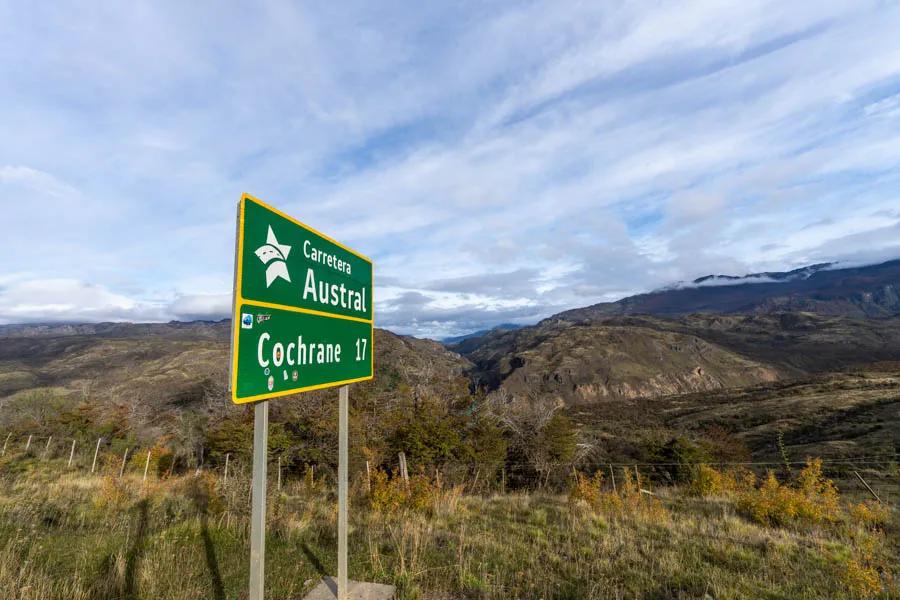
With the cool morning and knowledge that the Cochrane River trout are slow to feed in the mornings, we were not in a rush. In my moderately ok Spanish I learned that in Cochrane lived a woman Nico had been hoping to date. She also owned the coffee cafe in Cochrane. Since we had time to kill, I figured why not indulge Nico.
Cochrane lies at the southernmost end of the famous Carretta Austral. It runs for nearly 700 kms and has some of the most beautiful scenery on Earth. After having a coffee and another baked goodie at Cafe La Oveja Negra (Black Sheep Coffee) we drove through a few municipal streets, turned past the Cochrane rodeo and livestock fairgrounds, and headed out of town. We drove through a small canyon and then landed back in the lower Rio Baker valley. In the distance were the jagged peaks of the southern region of San Rafael National Park, and just beyond them, the Pacific Ocean.
We arrived at the Cochrane River and I immediately felt at home. When I am guiding in Montana I spend most of my time on spring creeks and smaller waters. Nico had me rig my lightest and softest 5 weight rod with a long leader tapered to 5X. The game on the Cochrane is patience mixed with a heavy dose of stalking and hunting. It didn’t take us long to find feeding fish. I shimmied down a bank, got myself into casting position and after a few good steeple casts, made my first drift to these so-called difficult Cochrane trout. And on the first drift, the trout ate it. The fish quickly jumped and burst with speed downstream…and gained its freedom. Nico’s knot held, I just didn’t give the fish a chance to run.
“Damn!” I said to myself. “I should have had that.” Clearly I had not adjusted from casting 7 weight rods and sink-tips to long leaders, soft rods, and light tippets.
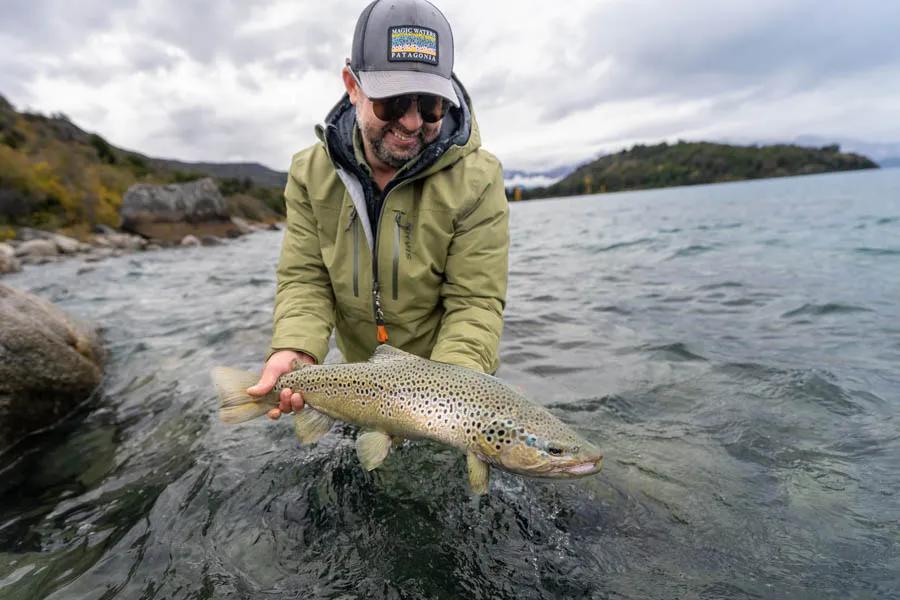
For the next hour or so, Nico and I stalked and hooked several very nice Cochrane trout…emphasis on hooked. Perhaps it was the extra baked goods and the stop for coffee in Cochrane, but it took me several fish to finally adjust to the long leaders and smaller flies. Eventually I landed a rainbow but not without incident as I waded in too deep–the crystal clear water of the Cochrane is deceiving–and water ran down into my waders. We landed the fish and had a lot to laugh about on the drive back along the Rio Baker, to the lodge to grab a cataraft and Eduardo and then head to Pasa Re La.
Once at Pasa Re La Nico quickly launched the boat. It wasn’t fifteen minutes and all the funky mojo I had on the Cochrane was erased as I hooked into a large brown trout. It ran, it dove, and I finally landed the beauty. High fives all-around and Nico was a proud guide in front of his boss. We fished till it was time to head back to the lodge with both Eduardo and I each landing a few more nice brown trout on sinking lines and big streamers.
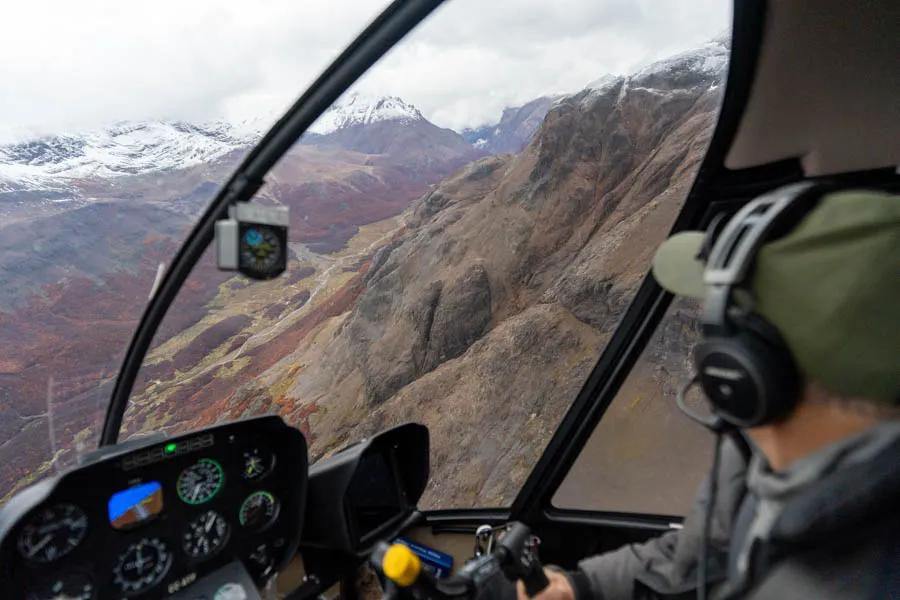
Day Four: Heli-fly Fly Fishing on a Remote Freestone
In nearly every famous trout fishing region on the planet there is that one river that remains mysterious and enigmatic. Of course there are great days and there are guides who claim they know all there is to know about that one river, but they are usually also the first ones to lay down excuses for the inexplicable.
The Jeinimeni is Patagonia Baker Lodge’s addictive enigma. This stunningly gorgeous freestone, flowing a light olive-green unlike any other color I’ve seen in a river, begins in the glaciers of Patagonia National Park, flows through two lagunas, and eventually drains into the massive Lago General Carrera. It is this connection that makes the Jeinimeni so special–large brown trout that live in the massive Lago General Carrera travel up the Jeinimeni from late February through early May to spawn in the national park waters.
A day fishing the Jeinimeni is arguably the most adventurous day out of Patagonia Baker Lodge. It begins with a very early departure from the lodge followed by a three hour drive along the shoreline of Lago General Carrera. Or, as in my case, if you are lucky, you can helicopter up and over the peaks and glaciers of Patagonia National Park. I was joined in the helicopter by Eduardo and fellow guests Carl and Dena.
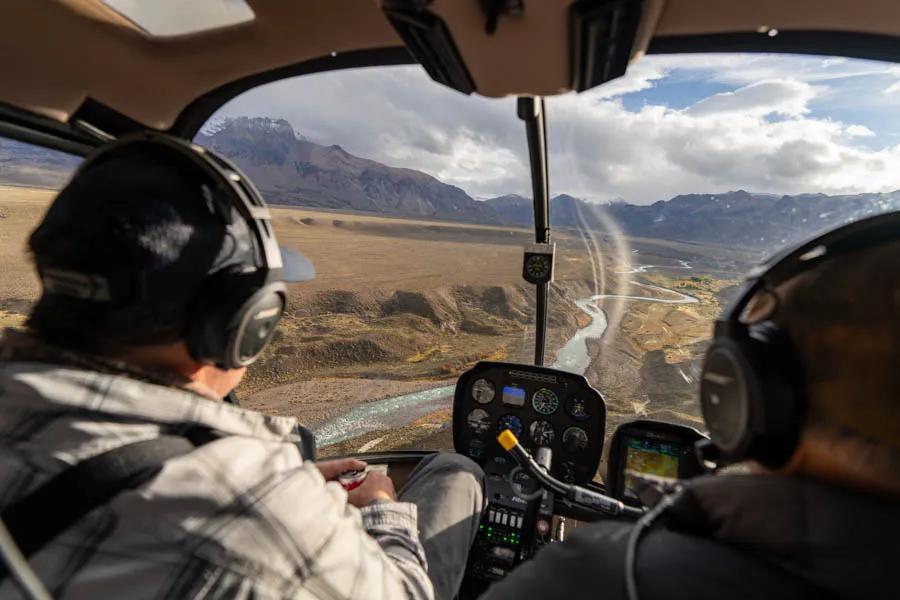
This wasn’t my first time in a helicopter as I’ve been fortunate to use one a few times to commute to fishing spots, but this was by far the most breathtaking and memorable experience to get to a trout stream. Carl, Dena, Eduardo, and myself enjoyed a normal breakfast, then drove about 20 minutes to a small town on Lago General Carrera where we embarked on the helicopter. After about 40 minutes of flying over and through some of the most stunning scenery I’ve experienced, we met our guides Nico and Matias on the river.
Because the Jeinimeni is exclusively walk-and-wade fishing, the guides loaded up lunch and beverages in day packs and the four of us began fishing. We fished 6 and 7 weight rods with both sink-tip and floating lines.
Within 15 minutes I had two very large browns strike at my fly, but the heart-stopping takes were too fast for me–I was most likely still mesmerized by the helicopter ride.
“These big boys strike fast!” Matias, my guide, exclaimed after both of my misses.
Carl and Eduardo along with Nico, leap-frogged Matias and I and quickly hiked a long way upstream of us. Dena opted out of fishing the Jeinimeni and instead enjoyed a lengthy and scenic return ride on the helicopter.
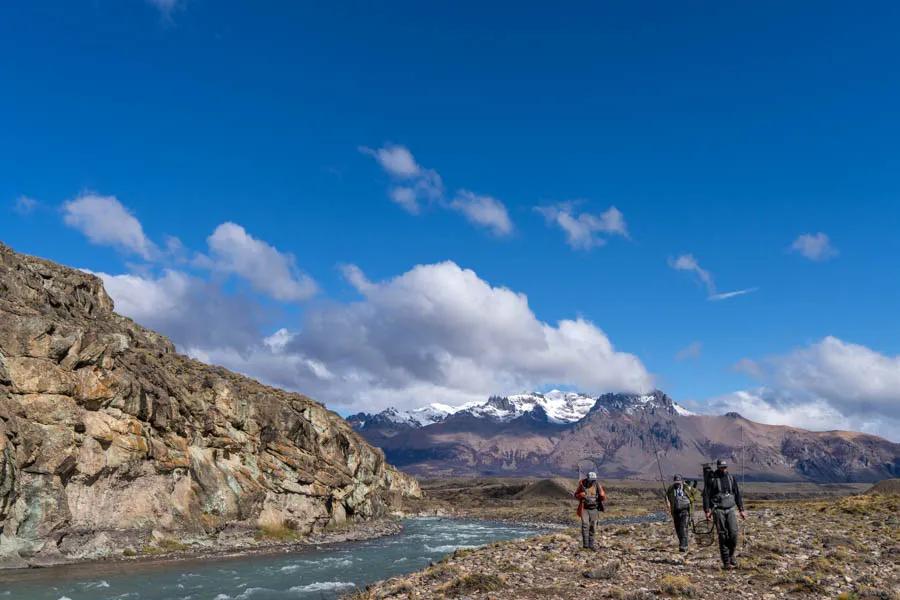
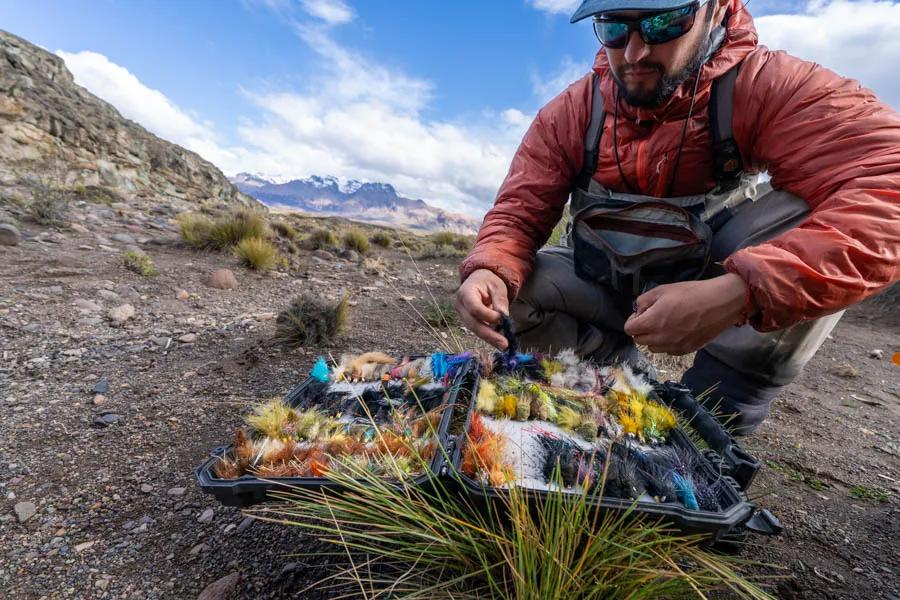
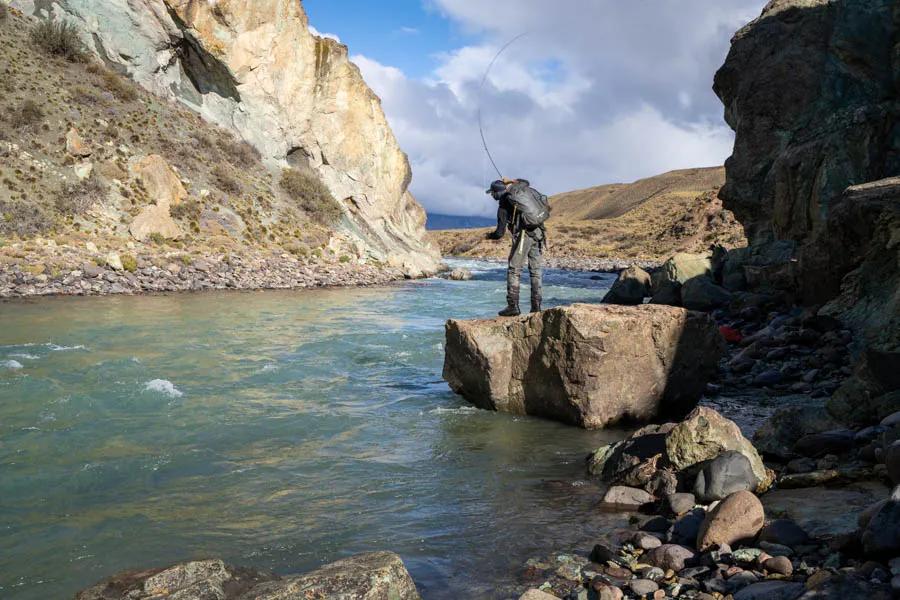
The Jeinimeni is a boulder-strewn freestone that cuts through several micro-canyons on its way to the lake. It is also the border of Chile and Argentina. The walking and wading isn’t difficult but it demands your attention at all times as the underfoot boulders and rocks can move. Add to the mix that the takes from the river’s large brown trout are unpredictable–they are ambush responses by the trout so you can rarely see them coming. When fishing the Jeinimeni there are very few moments you can afford to let your guard down.
Over the course of the day Matias and I counted about eight strikes, but the fish were not grabby and we did not land a fish on the Jeinimeni. However, I can remember each strike and the rush of adrenaline that ran through my body as the force of the water ran underneath my feet, the din of the rushing water broken only by Matias’ enthusiastic “cast again” and “hit it” instructions or after a missed hit Matias and I both stood glaring at each other in silence and then simultaneously saying “holy s**t” what was a big one.
My day on the Jeinimeni with Matias and the helicopter ride was my favorite day of the entire week and I didn’t even catch a fish! What was that saying again, “life is a journey and not a destination.”

Day Five: Lago Bertrand Head-hunting and PBL Deck Time
After such an epic adventure the previous day on the Jeinimeni I was ready for a little more relaxing day. So at breakfast when Marcelo assigned me with Nico to explore the bays, flats, and the outlet of Lago Betrand I did not complain. Paired with Nico, I enjoyed getting to know more about him and his hometown.
The weather was spectacularly sunny and calm. I enjoyed another protein backed breakfast and snagged a few extra rolls for mid-morning snacks. We drove five minutes from the lodge and launched the cataraft right in the heart of the small village of Puerto Bertrand. Nico lives just a few blocks from the boat ramp and his dog joined us for the launching of the boat. We also launched in the company of John and Megan, a father-daughter duo from Maine also at Patagonia Baker Lodge for the week, as well as John and Rodney.
While waiting for Nico to get the boat ready, from the boat launch near the outlet I began picking out rising trout. We had calm winds and clear skies–the perfect recipe for head-hunting. Within minutes Nico had me in casting range and I had my first large trout gulp my size 10 Parachute Adams. The fish leaped immediately and ran long and hard. These large, Lago Bertrand trout aren’t 12-inch Gallatin River fish.
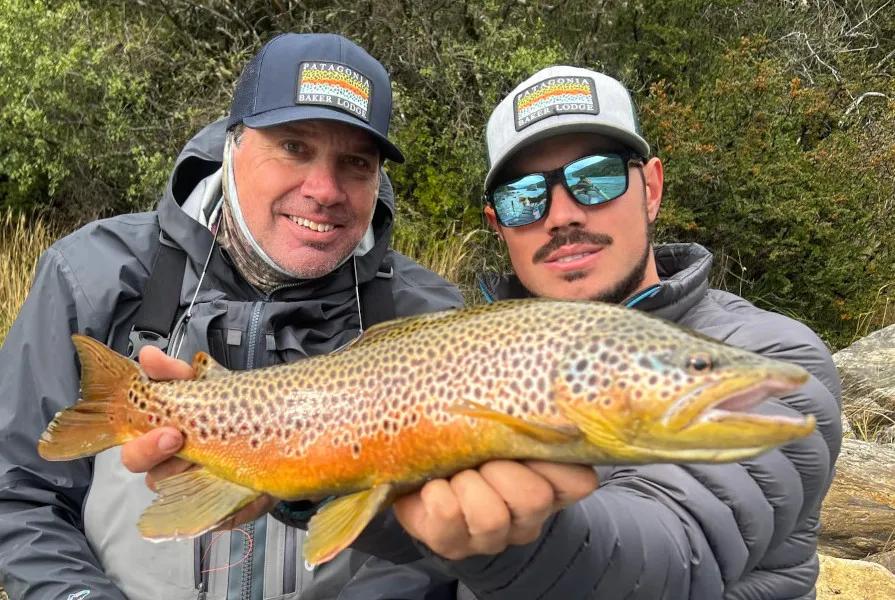
The outlet of Lago Bertrand fishes a lot like Montana’s Missouri, Bighorn, or a mega-version of one of the Paradise Valley Spring Creeks. The water is clear and flows with a variety of currents and seams. Perfect drifts are crucial. The ultramarine blue color of the water is captivating and in all directions are glacier-crowned peaks. I’ve headhunted fish in a lot of places on the planet and this is probably the most beautiful.
Nico and I traded off casting to rising trout for a few hours, catching several, missing several, and getting in plenty of laughs along the way. When the dry fly action subsided Nico motored the cataraft and we explored the numerous cliff walls along the lake searching for cruising brown trout.
After a late lunch–probably around 2 pm ish–we rendezvoused with John and Rodney. We agreed that this weather was ideal for sitting on the deck of the lodge, enjoying some cocktails and cigars. We fished for a little longer, raising some nice trout and finished the day at the lodge in the Autumn Patagonian sunshine, saturated with stories from a great trip…and we still had one more day.
While we enjoyed sunshine and cigars, other lodge guests Carl and Dena enjoyed a late afternoon session on the Rio Baker as the fishing continued to be good.
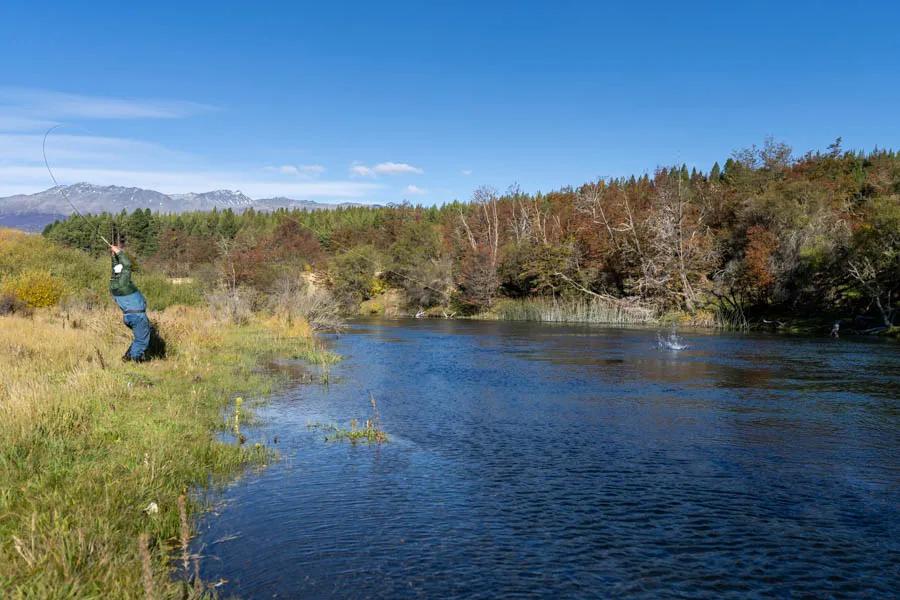
Day Six: Perfect Encore Day on the Cochrane
As my fly fishing journey has progressed in my life, I’ve become a fan of the smaller, intimate waters. Early in my fly fishing growth I longed for the big waters–the adrenaline of the Yellowstone River’s large riffles and wave trains or the notches in the belt of a Missouri River brown trout and the hipness of telling people about it.
These days I want my fly fishing stage to be small, the skills demanding with a sprinkling of potential for big fish. For that reason, I was stoked to return to the Cochrane with head guide Marcelo and explore a different section with a different guide.
For those of you that fish a lot in Montana with a variety of Montana fly fishing guides, you know each guide approaches fly fishing just a little differently. My earlier day on the Cochrane River with Nico was like a busman’s holiday, yet my day with Marcelo was more workman-like in nature. We covered a lot of water, stalked the banks, and cast only to big fish that we saw.
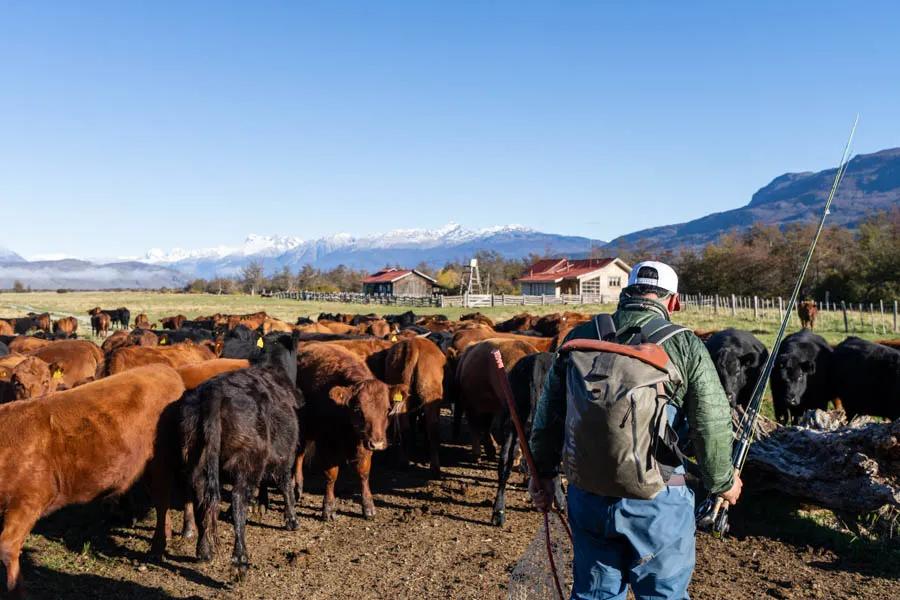
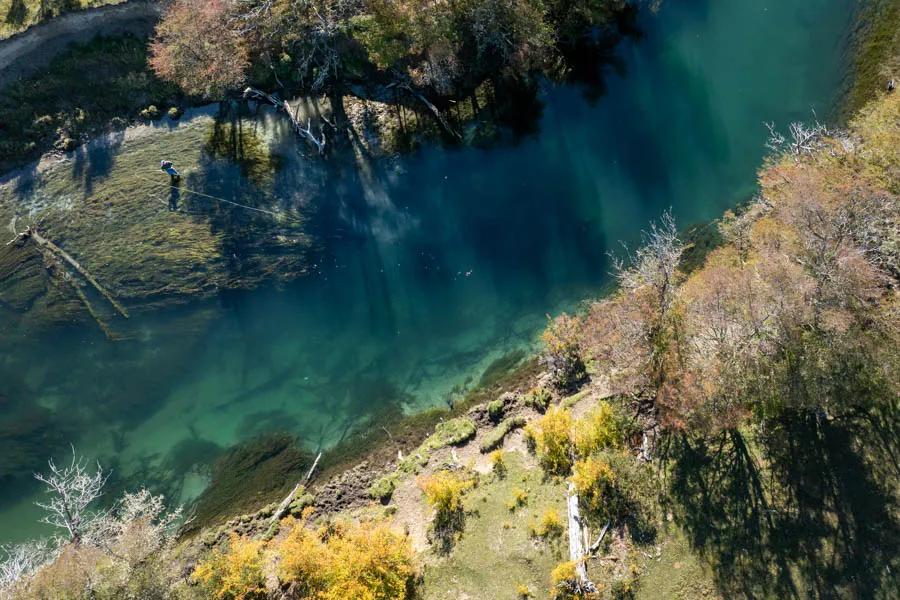

We started the day on a large estancia fishing the Cochrane just a few miles upstream of its confluence with the Rio Baker. Immediately, Marcelo had me casting to selective brown trout. He had me rigged with a 15-foot 5X leader and fishing a size 14 Purple Haze. I carefully walked down the bank and got into casting position. Once in position I made about a 40 foot cast and added a reach cast at the end. First drift over the trout…and gulp. A gorgeous eat from a gorgeous fish on a gorgeous day.
For the remainder of the day Marcelo and I traded off casting to sipping, cruising, and holding trout on the clear waters of the Cochrane. The weather, the company, and the fishing were a great end to a special week at Patagonia Baker Lodge.
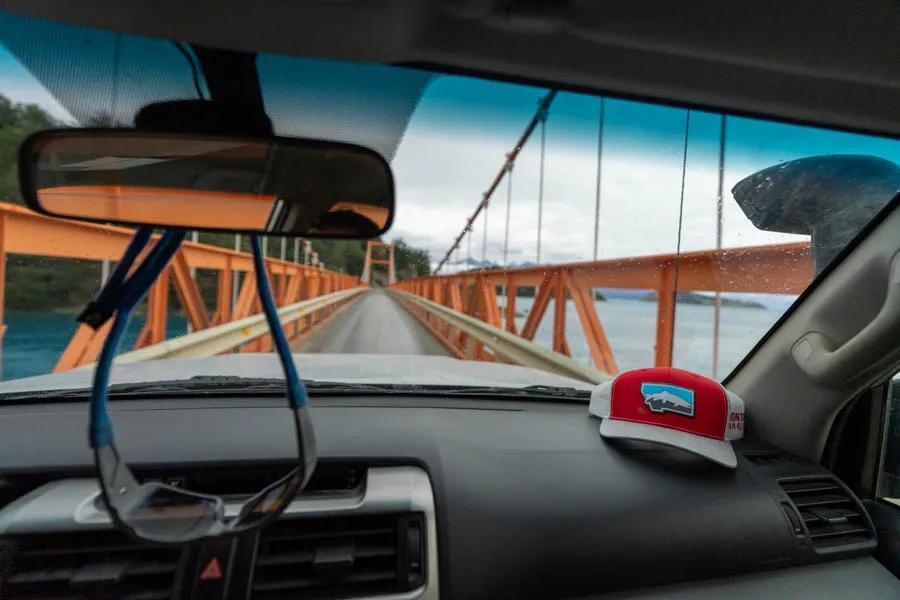
Travel Considerations and Overnight in Coyhaique
Anglers traveling to Patagonia Baker Lodge will most likely arrive Chile via an international flight. From there it is advised to connect to a domestic flight later that to Balmaceda–the small, regional airport servicing the primary angling region of southern Chile. Balmaceda is about 40 minutes from the Chilean town of Coyhaique.
If flying commercial flights, an overnight in Coyhaique is essential due to the 5 hours overland, yet very comfortable, ground transfer. Coyhaique is best described as a much smaller version of Bozeman, Montana. The town has several 2 and 3 star hotels and a variety of good restaurants. On our trip we had guests stay at two different hotels and both were clean, safe, comfortable and provided easy access to good restaurants. Two of our group arrived a full day early and enjoyed walking throughout Coyhaique in the crisp, Autumn air.
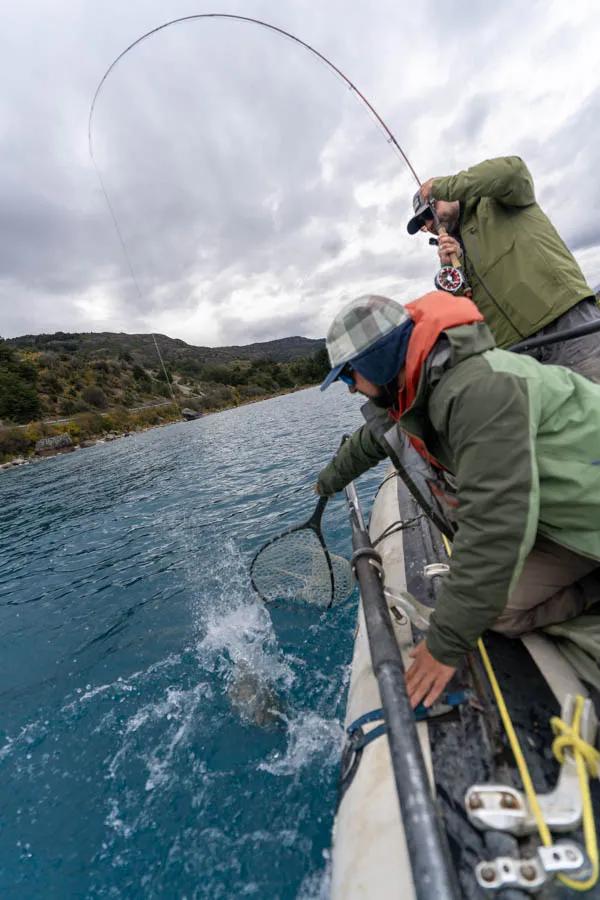
Rods, Reels, Flies, and Additional Gear Guidance
Rods. Most of the guides at PBL are going to want you to fish with 6 and 7 weight rods with the appropriate matching reel. On the lakes and Rio Baker, when fishing streamers I fished a very light and sensitive 7 weight and glad I did.
On the Cochrane I fished a 5 weight and did fine, but there were a few moments that I would’ve liked a 6 weight–just for that extra beef during a wind gust or two, but I just waited it out and recast.
The reel should have a good drag system, but most fish can be landed by utilizing a strip-in method. There were a few big fish on the Rio Baker that did require the drag system so it’d be a bummer to lose a fish because of poor drag.
The 5 weight is good for dry flies in little to no wind conditions. The 6 weight has multiple uses for this trip: dry flies in windy conditions, streamers in calm winds or smaller waters. The 7 weight for heavier streamers and a “go to” set up to fish any size streamer in windy conditions.
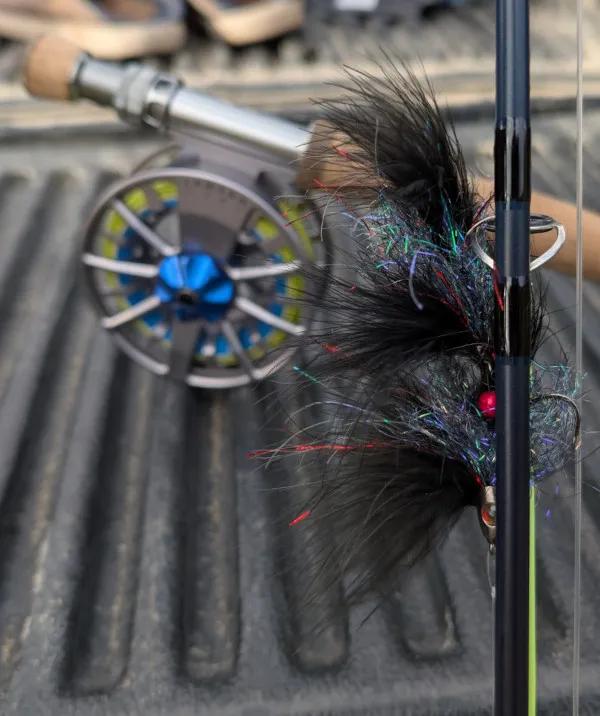
Fly lines. Having a variety of fly lines will allow for versatility during changing fishing conditions. Be sure to have the following:
5 weight, weight forward floating line
6 weight, weight forward floating line
6 weight (200 grain) sink-tip or sinking line, fast, and intermediate
7 weight (250 grain) sink-tip or sinking line, fast, and intermediate
Flies. While you do not need to bring a mobile fly shop with you, and the guides do have a good selection, be sure to have some of the following flies in a variety of sizes:
Coffey’s Articulated Sparkle Minnow, gold and white, size 4
Sculpzilla, olive and gold, black and purple, white, size 4
Peanut Envy, black and red, size 4
Cone Head Zonker, olive, black, size 4 & 6
Sparkle Minnow, sculpin, size 4 & 6
Mouse patterns
Stimulators, Royal is my favorite, size 8-12
Caddis, Blooms Hi-Vis is my favorite,, size 10-14
Parachute Purple Haze, size 10-14
Purple Haze Cripple, size 10-14
Fat Albert, tan, black, size 6-8
Griffiths Gnat, size 12-16
A few favorite beadhead nymphs in sizes 10-16 and 16-20 for the Cochrane.
Waders, outerwear, technical clothing, and layers. All of these are essential. Patagonia Baker Lodge can provide boots and waders but it is advised to bring your own. Quality rain jackets help with the rain and the wind. Pack a well-thought out and quality layering system as well–base layer, fleece, etc. Polarized sunglasses, sunscreen (30 spf minimum), and protective U.V. clothing for head and hands are also recommended.
